|
|
Post by another specialist on Aug 31, 2007 17:47:29 GMT
|
|
|
|
Post by another specialist on Aug 31, 2007 17:49:02 GMT
|
|
|
|
Post by another specialist on Sept 10, 2007 21:31:36 GMT
|
|
|
|
Post by another specialist on Oct 3, 2007 18:44:25 GMT
Today, Japan is supposed to have no wolves. Once, it had two types of native wolf, the Ezo wolf which lived on the northern island called Hokkaido and a wolf called the shamanu which lived in the south. Islands tend to produce dwarfed or miniature versions of mainland animals, and these wolves were no exception. The Ezo wolf looked like a small version of the Asian mainland wolf, but the shamanu was even more dwarfed. In fact, many scientists think the shamanu might have been a different species altogether, and not just a dwarfed subspecies. Scientists who take this view have called the shamanu Canis hodophilax. Most books that speak of the Japanese wolf are talking about the shamanu, not the Ezo wolf. The shamanu is also called the Honshu wolf, the shamainu, the yamainu, the nihon-okami and the yama-inu (several of these translate as "mountain dog" or various corruptions thereof). According to the scientific establishment, the last native wolf in Japan died in the first decade of the 20th century. The year 1905 is the most frequently mentioned official date of extinction, though most scientists now believe there was enough evidence to prove the shamanu existed in the wild until at least 1913. Japanese attitudes towards wolves were very different from the ideas most common in western cultures. The Japanese wolves were not hated like European wolves, instead they were deified in shrines, especially in the Chichibu Mountains. Peasants saw wolf spirits as protectors of crops. They could see that the wolves controlled deer and hares that would have otherwise been too numerous and a threat to crops. In the Edo period, the horse-breeding industry began seeing wolves as the enemy, and the introduction of the disease rabies from the mainland also created problems. As human populations expanded, wolves died. Either they were killed outright by humans or by rabies, or they simply lost food resources as wild prey died out. However, sightings have continued to the present day. Although official science has not admitted it, we can be pretty sure that at least one shamanu actually survived until at least 1950, because an authentic skin dating to that time was found in a shrine (giving wolf pelts to shrines was considered a holy act). The Japanese wolf almost certainly survived for at least a few decades after it had been officially declared extinct. The real question is whether it is alive today. In the 1970s a supposed wolf carcass was delivered to Japanese scientific authorities for identification. It was simply never seen again, nor was there any pronouncement on what it was. Japanese scientists have looked at a number of wolf-like animals of the same size as the shamanu since then, but they have not overturned the diagnosis of extinction. Believers say that the Japanese scientists are afraid to interfere with orthodox beliefs and official history. The Japanese have a long cultural history of respecting official pronouncements made by authority figures, to the extent that overturning a fact that has been accepted for decades would be extremely unsettling, much more so than it would be to scientists from western cultures. Supposedly, this cultural taboo is a strong reason to actively destroy any evidence that might make a fool out of authority figures. Whether the shamanu survived into the 1970s or not is hard to prove because of this missing evidence. Now, scientists may be too late. Most modern sightings are confined to the Kii Peninsula and these sightings become less numerous all the time. If the shamanu is not already extinct, it is surely struggling and more likely to go extinct with every passing year. The question of whether the shamanu still exists is vitally important. The disappearance of the Japanese wolf from most or all of its habitat has completely disrupted Japanese forest ecology. Deer and boar populations skyrocket, devestating all edible plant life. The tanuki (another species of wild dog) and fox cannot fill the role that the wolf once filled. The Japanese wolf is what is known as a keystone species, a top predator that is needed in order for the ecosystem to function. Therefore, there is talk of introducing mainland Asian wolves to Japan in order to correct this imbalance. However, this introduction would be a disaster if any shamanu are left, because it would ensure their extinction through crossbreeding or competition. If any native Japanese wolves are left, they need to be saved before we introduce another type of wolf. www.newanimal.org/japwolf.htm |
|
|
|
Post by another specialist on Aug 9, 2008 17:42:27 GMT
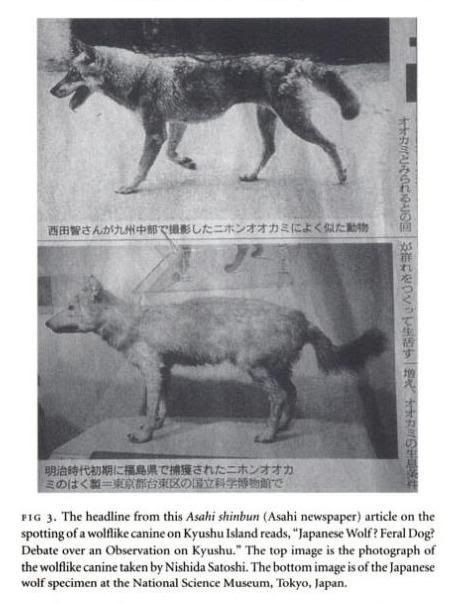 The Lost Wolves of Japan By Brett L. Walker, William Cronon |
|
|
|
Post by another specialist on Aug 9, 2008 17:50:14 GMT
 The Lost Wolves of Japan By Brett L. Walker, William Cronon |
|
|
|
Post by another specialist on Aug 9, 2008 17:53:15 GMT
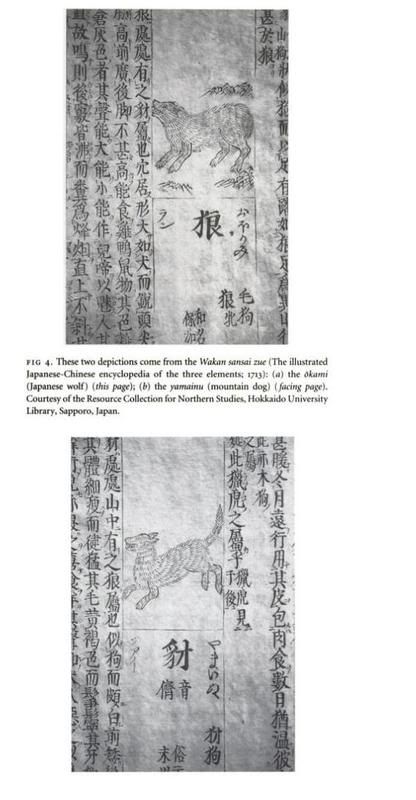 The Lost Wolves of Japan By Brett L. Walker, William Cronon |
|
|
|
Post by another specialist on Aug 9, 2008 17:56:10 GMT
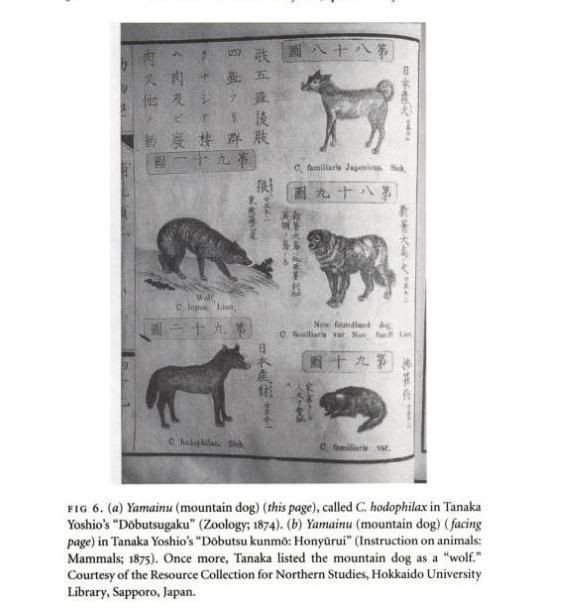 The Lost Wolves of Japan By Brett L. Walker, William Cronon |
|
|
|
Post by another specialist on Aug 9, 2008 17:56:29 GMT
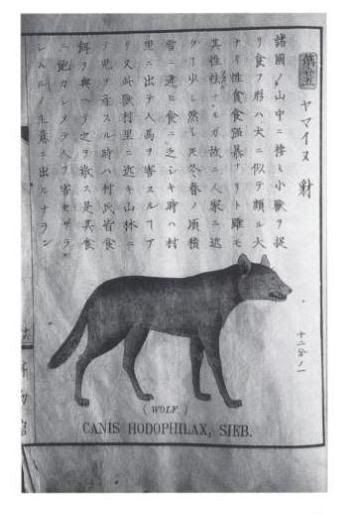 The Lost Wolves of Japan By Brett L. Walker, William Cronon |
|
|
|
Post by another specialist on Aug 9, 2008 18:03:04 GMT
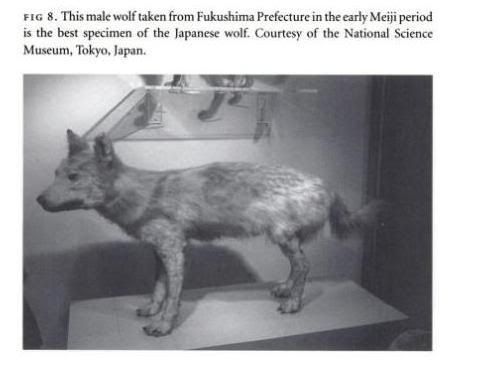 The Lost Wolves of Japan By Brett L. Walker, William Cronon |
|
|
|
Post by another specialist on Aug 9, 2008 18:07:52 GMT
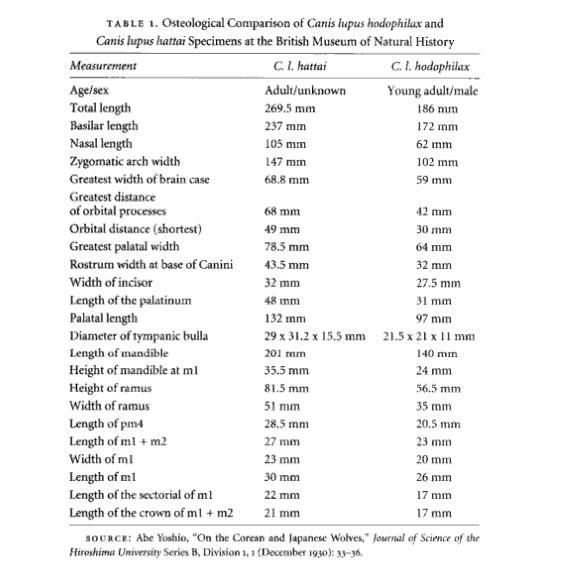 The Lost Wolves of Japan By Brett L. Walker, William Cronon |
|
|
|
Post by surroundx on Apr 19, 2014 7:15:07 GMT
|
|
|
|
Post by surroundx on Dec 5, 2014 5:47:18 GMT
Reconstructing the colonization history of lost wolf lineages by the analysis of the mitochondrial genomeAbstract The grey wolves (Canis lupus) originally inhabited major parts of the Northern hemisphere, but many local populations became extinct. Two lineages of wolves in Japan, namely, Japanese or Honshu (C. l. hodophilax) and Ezo or Hokkaido (C. l. hattai) wolves, rapidly went extinct between 100 and 120 years ago. Here we analyse the complete mitochondrial genome sequences from ancient specimens and reconstruct the colonization history of the two extinct subspecies. We show a unique status of Japanese wolves in wolf phylogeny, suggesting their long time separation from other grey wolf populations. Japanese wolves appeared to have colonized the Japanese archipelago in the Late Pleistocene (ca. 25,000–125,000 years ago). By contrast, Ezo wolves, which are clearly separated from Japanese wolves in phylogeny, are likely to have arrived at Japan relatively recently (<14,000 years ago). Interestingly, their colonization history to Japan tallies well with the dynamics of wolf populations in Europe and America during the last several millennia. Our analyses suggest that at least several thousands of wolves once inhabited in the Japanese archipelago. Our analyses also show that an enigmatic clade of domestic dogs is likely to have originated from rare admixture events between male dogs and female Japanese wolves. Source: Matsumura, Shuichi, Inoshima, Yasuo and Ishiguro, Naotaka. (2014). Reconstructing the colonization history of lost wolf lineages by the analysis of the mitochondrial genome. Molecular Phylogenetics and Evolution 80: 105-112. [ Abstract]
|
|
|
|
Post by surroundx on Apr 7, 2015 14:12:26 GMT
A re-examination of C. J. Temminck's sources for his descriptions of the extinct Japanese wolfAbstract Unpublished manuscripts sent from Japan by the German physician and naturalist Philipp Franz von Siebold (1796–1866) to the Dutch zoologist Coenraad Jacob Temminck (1778–1858) show that Siebold possessed exclusive information about the now extinct Japanese wolf. This was confounded or ignored by Temminck when he used Siebold as source for his section on Japanese dogs and wolves in the volume on mammals in Fauna japonica with Siebold as general editor (1842). Temminck had used Siebold's information for his naming of the Japanese wolf as Canis hodophilax in 1839. Temminck's descriptions are analysed in comparison with Siebold's manuscripts to clarify how Temminck obscured Siebold's information. This paper includes reproductions of two unpublished drawings from Siebold's draftsman in Japan and a brief discussion of the zoological status of the Japanese wolf. Additionally, a translation of the most important of Siebold's manuscripts is appended. Source: Funk, Holger. (2015). A re-examination of C. J. Temminck's sources for his descriptions of the extinct Japanese wolf. Archives of natural history 42(1): 51-65. [ Abstract]
|
|
|
|
Post by koeiyabe on Apr 27, 2015 17:24:26 GMT
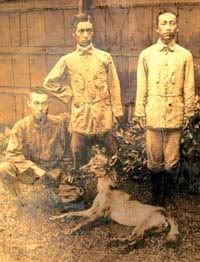 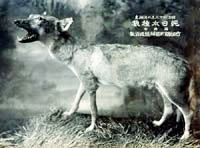  The world’s smallest variety of wolf, the Japanese wolf, also called the Honshu Wolf (Canis lupus hodophilax), supposedly became extinct in 1905 in Nara prefecture. But did some survive beyond that date? And was there physical proof of this, in 1910 in Fukui prefecture? Sightings of the Japanese wolf persist to the present. A new debate is occurring currently in Japan that the extinction date may have been incorrect, almost immediately. Intriguingly, finding a taxidermy example of the Honshu Wolf presently is quite difficult. Only five mounted specimens are known worldwide, three in Japan, one in the Netherlands (which is pictured in Swift as a Swallow), and the supposedly final 1905 animal, which is located at the British Museum. But was there another taxidermy mount that proved these wolves lived beyond 1905? In Japan, a recent Asahi News discussion has surfaced regarding the photographs you see here. I am grateful to cryptozoology historian American Brent Swancer living in Japan, who has passed info from his translation along to me. Supposedly killed in 1910 in Fukui, the Japanese wolf in the above photo is apparently genuine. The article explains that the last officially known Japanese wolf died in 1905, yet here is one that was allegedly killed in 1910. Unfortunately, the body was destroyed in a fire, according to the article. The picture in the middle is a stuffed specimen of that last known Japanese wolf and the picture at the bottom is the farm where the wolf at top was shot. The two photos today remain as the only real evidence that this wolf existed since the body has long since been destroyed. In the Asahi News article there is a mention that in an issue of the Fukui agricultural magazine of the time, zoo staff had examined the animal the day after the shooting in 1910. They came to the conclusion that it was indeed a Japanese wolf. Unfortunately, it seems that that is as far as the examination went. It appears that those who advocate that this was a Japanese wolf point to that Fukui magazine article, as well as comparing the morphology of the animal pictured to data on the Japanese wolf. But it is inconclusive and not enough to change the common historical record that the last known specimen died in Nara in 1905. Brent Swancer www.cryptomundo.com/cryptozoo-news/honshuwolf/Here are links of detailed information (in Japanese) on anatomical description of the captured wolf in 1910. The specimen was stored in an elementary school but was burned out due to an airstrike during WWII. The zoologist working at a junior high school analyzed the wolf and asserted that this was a pure species but the extinction year is still officially 1905. Currently, two zoologists researching old records and the photos believe the wolf is a pure species and have a chance to change the extinction year but there is still a lack of conclusive evidences. www.geocities.jp/canisyagi/science/fukui.htmlmegalodon.jp/2007-1006-2236-27/mytown.asahi.com/fukui/news.php?k_id=19000130701090001 |
|
|
|
Post by koeiyabe on Apr 28, 2015 2:04:18 GMT
 The statue of Japanese wolf is erected at Washikaguchi, Higashi-Yoshino Village, Nara Prefecture where the last was seen in 1905. |
|
|
|
Post by koeiyabe on Dec 12, 2015 19:27:44 GMT
"The Earth Extinct Fauna (in Japanese)" by Tadaaki Imaizumi (1986)  |
|
|
|
Post by surroundx on Mar 9, 2016 13:42:43 GMT
Ishiguro, Naotaka et al. (2016). Japanese Wolves are Genetically Divided into Two Groups Based on an 8-Nucleotide Insertion/Deletion within the mtDNA Control Region. Zoological Science 33(1): 44-49. [ Abstract] |
|
|
|
Post by koeiyabe on Jun 18, 2016 0:12:44 GMT
|
|
|
|
Post by surroundx on Oct 22, 2016 3:19:14 GMT
|
|